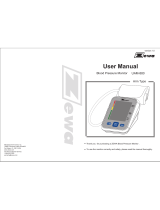
The signs below might be in the user manual, labeling or other component.
They are the requirement of standard and using.
Safety Information
Symbol for “MANUFACTURER”
Symbol for “SERIAL NUMBER”
Symbol for “TYPE BF APPLIED
PART”
Symbol for “DIRECT CURRENT”
Symbol for “MANUFACTURE
DATE” and Made in China
SN
Symbol for “RECYCLE”
INTRODUCTIONINTRODUCTION
4 5
Refer to instruction manual/
booklet
To signify that the instruction
manual/booklet must be read.
CE marking indicates that a
product has been assessed by
the manufacturer and deemed
to meet EU safety, health and
environmental protection
requirements. It is required for
products manufactured
anywhere in the world that are
then marketed in the EU.
The symbol indicates that the product
should not be discarded as unsorted
waste but must be sent to separate
collection facilities for recovery and
recycling.
Indicates that caution is necessary
when operating the device or control
close to where the symbol is placed,
or that the current situation needs
operator awareness or operator
action in order to avoid undesirable
consequences.
CAUTION
* This device is intended for indoor, home use.
* This device is not intended for public use.
* This device is portable, but it is not intended for use during patient transport.
* This device is not suitable for continuous monitoring during medical emergencies or operations.
* This device is intended for no-invasive measuring and monitoring of arterial blood pressure. It is
not intended for use on extremities other than the arm, or for any purpose other than obtaining a
blood pressure measurement.
* This device is for adults. Do not use this device on neonates or infants. Do not use it on children
unless otherwise instructed by a medical professional.
* Do not use on the women in pregnant, including pre-eclamptic, patients.
* The device is not suitable for use on patients with implanted, electrical devices, such as cardiac
pacemakers, defibrillators.
* The effectiveness of this device has not been established for use:
-on users with common arrhythmias such as atrial or ventricular premature beats or atrial
fibrillation,
-on users with peripheral arterial disease,
-on users undergoing intravascular therapy, or with arteriovenous (AV) shunt.
Consult a medical professional before use.
* Do not use this device for diagnosis or treatment of any health problem or disease. Contact your
physician if you have or suspect any medical problem. Do not change your medications without
the advice of your physician or health care professional.
* If you are taking medication, consult your physician to determine the proper time to measure
your blood pressure.
* This device may be used only for the intended use described in this manual, the manufacturer
shall have no liability for any incidental, consequential, or special damages caused by misuse or
abuse.
* Report any unexpected operation or events to the manufacturer.
* Do not apply the cuff on an arm that has an intravenous drip or a blood transfusion attached.
* Warning: Do not kink, fold, stretch, compress, or otherwise deform the tube during measuring, as
the cuff pressure might continuously increase, which could prevent blood flow and result injury.
* Warning: Taking blood pressure measurements too frequently could disrupt blood circulation and
cause injuries.
* Warning: Do not apply cuff to areas on patient where skin is delicate or damaged. Check cuff site
frequently for irritation.
* Warning: Do not place the cuff on the arm of a person whose arteries or veins are undergoing
medical treatment, i.e. intra-vascular access or intra-vascular therapy or an arteriovenous (A-V)
shunt, which could disrupt blood circulation and cause injuries.
* Do not place the cuff on the arm on the same side of a mastectomy (especially when lymph
nodes have been removed). it is recommended to take measurements on the unaffected side.
* Do not wrap the cuff on the same arm to which another monitoring device is applied. One or both
devices could temporarily stop functioning if you try to use them at the same time.
* Please check that the operation of the device do not result in prolonged impairment of patient
blood circulation.
* Warning: On the rare occasion of a fault causing the cuff to remain fully inflated during
measurement, loosen and remove the cuff immediately. Prolonged high pressure applied to the
arm (cuff pressure >300 mmHg or constant pressure >15 mmHg for more than 3 minutes) might
lead to bruising and discolored skin.
* Warning: Do not use this device with high-frequency (HF) surgical equipment at the same time.

















